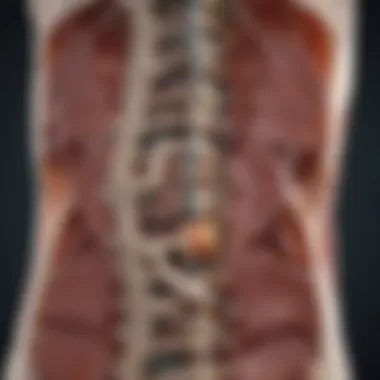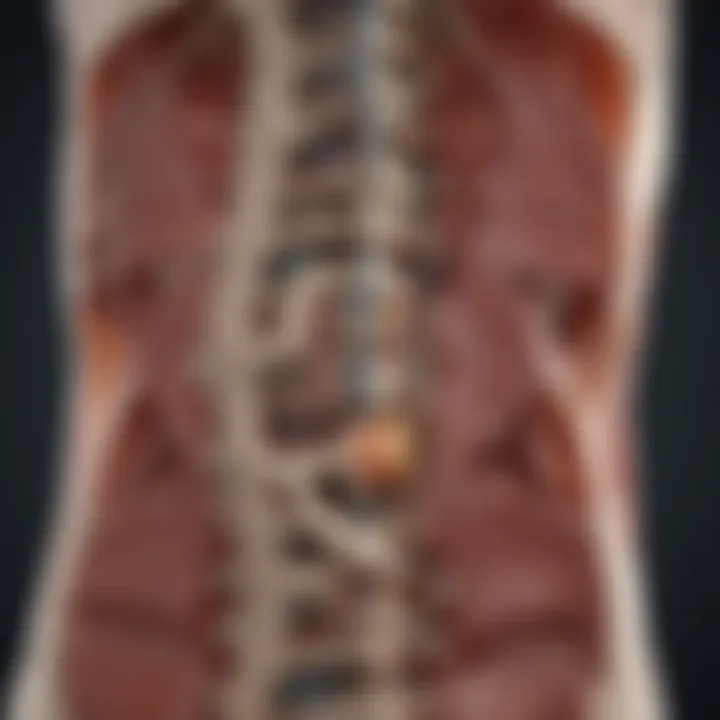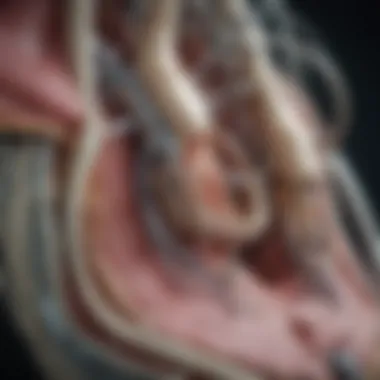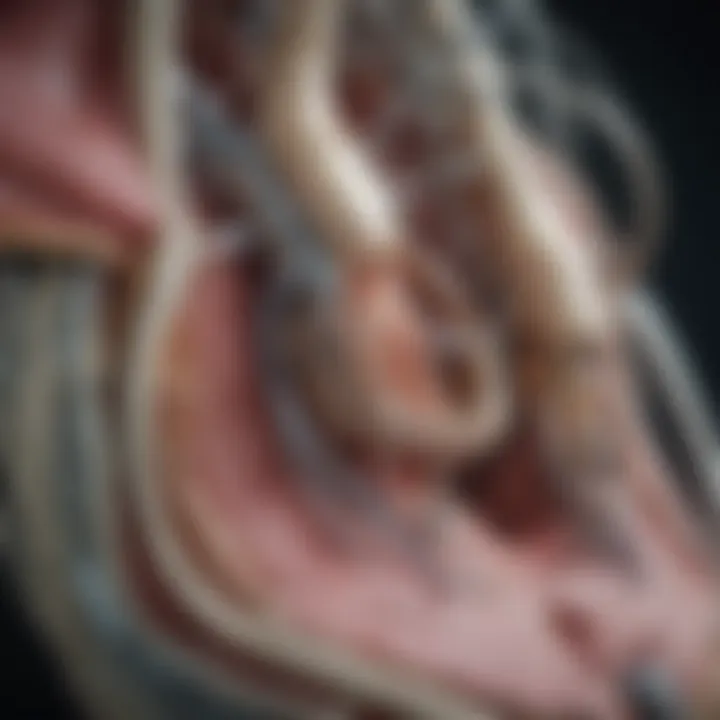Understanding Spinal Lumbar Fusion: An In-Depth Exploration


Intro
Spinal lumbar fusion represents a significant surgical intervention designed to solve various spinal issues. The journey into understanding this complex topic begins with grasping the essentials of the procedure. Lumbar fusion involves the joining of two or more vertebrae in the lower back, effectively eliminating movement between them. This approach is often a solution for patients suffering from chronic pain or instability due to conditions such as degenerative disc disease, spondylolisthesis, or spinal stenosis. The objective is to provide pain relief and restore functional mobility, contributing positively to the patient’s quality of life.
Despite the benefits, spinal lumbar fusion is not without its challenges and controversies. Surgeons and patients alike must weigh the potential advantages against risks such as infection, nerve damage, or the possibility of adjacent segment disease. The evolving landscape of spine surgery further complicates decision-making, making it crucial for patients to be well-informed about the available options, the expected outcomes, and the associated risks.
In this section, we will delve into the purpose of this article, as well as its relevance across multiple disciplines. We aim to provide users with a thorough understanding of spinal lumbar fusion, which will facilitate informed decision-making in clinical settings as well as personal health choices.
Preamble to Spinal Lumbar Fusion
The topic of spinal lumbar fusion is critical for understanding contemporary spinal surgery. This surgical intervention aims to stabilize the spine and eliminate painful motion at specific segments. There is a significant impact on patients' quality of life when conditions like degenerative disc disease and spondylolisthesis necessitate this procedure. In this section, we will discuss the very essence of lumbar fusion by defining it and exploring its historical context.
Definition of Lumbar Fusion
Lumbar fusion refers to a surgical procedure where two or more vertebrae in the lower back are joined together. The goal of this operation is to stop movement between the vertebrae, hence reducing pain and improving stability. This can involve using bone grafts and screws to promote the fusion process, which is essential for achieving long-term relief.
To put it simply, when fusion occurs, the patient may experience a significant reduction in discomfort and an enhancement in functional capacity. Understanding this definition is vital, as it lays the groundwork for comprehending the various techniques and outcomes of the procedure.
Historical Context and Evolution
The practice of spinal fusion has a long history, tracing back to ancient medical practices aimed at treating spine-related issues. However, it wasn't until the 20th century that surgical techniques advanced significantly. Early fusion techniques focused on simple methods of immobilizing the spine, often with limited success.
As technology and medical knowledge evolved, so did the approach to lumbar fusion. In the late 20th century, the introduction of more sophisticated surgical tools and imaging technologies enhanced the precision of these procedures. Today, various techniques exist, from traditional open surgery to minimally invasive methods that significantly minimize recovery time.
Lumbar fusion continues to evolve, with ongoing research revealing new insights that facilitate better patient outcomes.
Lumbar fusion continues to evolve, with ongoing research revealing new insights that facilitate better patient outcomes.
The advancements made in surgical techniques and post-operative care underscore the continuous pursuit of excellence within the field of spinal surgery. This context highlights the importance of lumbar fusion in responding to complex spinal diseases, making it a pivotal topic in modern medicine.
Indications for Lumbar Fusion
The topic of indications for lumbar fusion holds significant relevance in the context of spinal surgery. Recognizing when to proceed with this invasive procedure is critical for optimal patient outcomes. Patients often present with various conditions that create the need for surgery, but not all cases call for a fusion.
Understanding the specific conditions that warrant lumbar fusion is crucial. Each diagnosis is unique and must be carefully assessed to determine if surgical intervention will yield improvements in pain relief, function, and overall quality of life.
The following subsections explore the main indications in detail, offering insight into the underlying issues that lead clinicians to recommend lumbar fusion.
Degenerative Disc Disease
Degenerative disc disease is a common reason for lumbar fusion. It occurs when the intervertebral discs begin to wear down, which can lead to pain, reduced mobility, and nerve irritation. Patients often present with chronic back pain that does not respond to conservative treatments such as physical therapy or medications.
The decision to fuse segments in the spine may stem from persistent pain despite other interventions. By stabilizing the affected discs, the surgery aims to alleviate discomfort and improve function. Moreover, reviews of recent studies highlight that many patients report significant pain reduction following spinal fusion for this condition.
Spondylolisthesis
Spondylolisthesis occurs when one vertebra slips out of place onto another. This displacement can lead to increased pressure on nerves, causing pain, weakness, or numbness in the legs. Patients often experience severe discomfort that limits their daily activities.
In cases where nonsurgical measures yield no results, lumbar fusion can stabilize the affected area. This surgical technique aims to restore normal alignment and function. Long-term studies indicate that surgical intervention often leads to improved mobility and quality of life.
Spinal Stenosis
Spinal stenosis results from a narrowing of the spinal canal, which places pressure on the spinal cord and nerves. Symptoms may include pain, tingling, or weakness, particularly in the lower back and legs.
When conservative treatments like injections or physical therapy fail, lumbar fusion may be indicated. By eliminating movement between vertebrae, the procedure can alleviate pressure and improve symptoms. Recent advancements in surgical techniques have enhanced the efficacy of this treatment, resulting in a higher success rate and better patient satisfaction.
Post-Traumatic Instability
Injuries to the spine can lead to instability, particularly if fractures or soft tissue injuries are involved. Patients may experience significant discomfort and difficulty in performing everyday tasks. When instability persists despite comprehensive nonsurgical management, lumbar fusion becomes a necessary step.
Surgical stabilization aims to prevent further injury and enhance the recovery process. Studies indicate that timely surgical intervention leads to better long-term outcomes and recovery in individuals with post-traumatic instability.
The decision to proceed with lumbar fusion should be backed by thorough assessment and consideration of individual patient factors to ensure maximizing the benefits of the surgery.
The decision to proceed with lumbar fusion should be backed by thorough assessment and consideration of individual patient factors to ensure maximizing the benefits of the surgery.


Surgical Techniques in Lumbar Fusion
Surgical techniques in lumbar fusion are crucial for effectively addressing spinal disorders. The choice of technique significantly influences patient outcomes and recovery. Surgeons tailor their approaches based on the specific conditions being treated, as well as the individual's overall health.
Traditional Open Surgery
Traditional open surgery for lumbar fusion involves making a larger incision to gain access to the spine. This method allows the surgeon to directly visualize the anatomical structures, facilitating more straightforward placement of screws and grafts. One of the main advantages of this technique is that it provides the surgeon with abundant space to work, which is especially valuable in complex cases.
However, open surgery comes with a longer recovery period due to muscle and soft tissue disruption. Patients frequently experience more postoperative pain and a higher risk of complications such as infection. Despite these challenges, traditional open surgery remains a standard approach when more control is necessary during the procedure.
Minimally Invasive Techniques
Minimally invasive techniques have gained popularity in recent years due to their potential to reduce recovery time and associated risks. This approach utilizes smaller incisions, which minimizes tissue damage and preserves muscle integrity.
Benefits of Minimally Invasive Surgery
The primary benefit of minimally invasive surgery is the reduction in postoperative pain. Patients often report quicker returns to normal activities after this type of procedure. Furthermore, smaller incisions lead to decreased scarring, reduced bleeding, and a shorter hospital stay. These factors collectively contribute to a more favorable overall experience for the patient.
The capacity to achieve surgical goals with minimal disruption is a key characteristic that makes this an attractive option in lumbar fusion.
Challenges of Minimally Invasive Approaches
Despite its benefits, minimally invasive lumbar fusion poses certain challenges. The techniques may be technically demanding and require advanced surgical skills. Moreover, limitations in visualization through smaller incisions can complicate certain surgical maneuvers.
Surgeons may face difficulties in achieving the same level of correction and stability as seen in traditional methods. The training and the equipment required can also be a barrier, making this approach less widely available.
Types of Bone Grafts
Bone grafts play a vital role in the success of lumbar fusion as they provide the necessary biological support for bone healing.
Autografts
Autografts involve harvesting bone from the patient's body, usually from the iliac crest. This method is considered the gold standard due to its superior osteogenic potential. The key characteristic of autografts is that they significantly enhance the likelihood of fusion. However, this technique is associated with additional surgical sites and potential complications such as donor site pain and infection.
Allografts
Allografts are sourced from cadaveric donors and provide an alternative to autografts. One key benefit of allografts is that they eliminate the need for a second surgical site. They can be readily available and are often safe due to rigorous screening processes. However, allografts have a lower osteogenic capacity compared to autografts, which means the fusion rate may be less predictable.
Bone Substitutes
Bone substitutes are synthetic materials that mimic the properties of bone. Use of these materials is increasing, providing an effective alternative to natural grafts. They can offer the advantage of avoiding donor site morbidity altogether. However, effectiveness varies depending on the specific type of material used, and some substitutes lack biological properties necessary for optimal fusion.
Overall, understanding these surgical techniques and the types of bone grafts can significantly influence patient outcomes and the approach to specific spinal conditions, ultimately impacting the recovery journey.
Understanding the Fusion Process
Understanding the fusion process is a vital aspect of spinal lumbar fusion. This process not only encompasses the surgical methodology but also the biological and healing mechanisms that ensure the success of the operation. The fusion aims to stabilize the spine, alleviating pain and restoring function. Comprehending the different stages of biological healing highlights the importance of patient care and rehabilitation post-surgery.
By having a clear picture of how fusion occurs, patients and healthcare professionals can set realistic expectations about recovery and the overall effectiveness of the procedure.
Biological Mechanisms of Fusion
The biological mechanisms of fusion involve a complex interplay of cells, growth factors, and the body's natural healing response. After surgery, the body begins a healing process that promotes the growth of new bone material between the vertebrae. This occurs through various stages:
- Inflammation Stage: Immediately post-surgery, this stage is characterized by the body's response to injury. Blood vessels expand, increasing blood flow to deliver necessary nutrients and immune cells.
- Cell Proliferation Stage: Within the following days, specialized cells called osteoblasts begin to form new bone. This is crucial as it lays the groundwork for a successful fusion.
- Bone Remodeling Stage: This stage can take months to years. The newly formed bone undergoes a process to become stronger and more efficient. Osteoclasts help in removing excess tissue while osteoblasts continue to build new structure.
Understanding these stages aids in appreciating how intricate the healing process is. It also explains why some patients require more time and support for full recovery.
Timeline for Fusion and Recovery
The timeline for fusion and recovery can vary greatly among individuals. Several factors influence this timeline:
- Age: Generally, younger patients may experience faster healing than older adults.
- Health Status: Pre-existing medical conditions can impact recovery times.
- Surgical Technique: Minimally invasive techniques often result in quicker recovery compared to traditional methods.
Typically, patients may begin to see early signs of fusion within three to six months. However, complete recovery can take up to one year or more. During this period, patients are encouraged to participate in physical therapy to strengthen surrounding muscles and enhance stability.


Here is a general timeline one might expect:
- Weeks 1-2: Initial recovery; focus on pain management.
- Weeks 3-6: Gradual increase in mobility; light physical therapy may start.
- Months 3-6: Imaging may be done to assess progress; more intensive rehabilitation exercises introduced.
- Months 6-12: Continued strengthening of the spine; full recovery and return to previous activity levels may occur.
Effective rehabilitation and proper post-operative care play a pivotal role in achieving successful fusion outcomes.
Effective rehabilitation and proper post-operative care play a pivotal role in achieving successful fusion outcomes.
Recognizing these timelines helps patients understand their journey to recovery. It also helps physicians tailor rehabilitation programs to match patient needs and goals.
By delving into the fusion process, it becomes evident that both biological understanding and patient engagement are central to successful spinal lumbar fusion.
Outcomes of Lumbar Fusion
The outcomes of lumbar fusion are crucial in evaluating the effectiveness and desirability of this surgical procedure. Understanding these outcomes helps patients make informed decisions regarding their treatment options. It also aids healthcare providers in setting realistic expectations and monitoring recovery. The focus here is on the success rates, overall effectiveness, and the impact on patient satisfaction and quality of life.
Success Rates and Effectiveness
Lumbar fusion success rates generally vary depending on multiple factors, including the specific condition being treated, the surgical technique used, and patient characteristics. Research indicates that success rates can range from 70% to over 90% for certain conditions.
Success in lumbar fusion often means a significant reduction in pain and improvement in function. However, defining what success means can differ among patients. Some may feel successful if their pain level decreases, while others may have higher expectations based on their pre-surgery condition.
Multivariate analyses suggest that the following factors can influence success rates:
- Age: Younger patients typically have better outcomes.
- Body Mass Index (BMI): Lower BMI often correlates with higher success.
- Pre-existing Conditions: Patients with fewer comorbidities may have improved results.
- Smoking Status: Smoking can negatively impact healing and success rates.
Long-term follow-up studies have shown that outcomes improve over time for some patients. It is also important to note that individual variability plays a role in recovery and success.
Patient Satisfaction and Quality of Life
The influence of lumbar fusion on patient satisfaction and quality of life is a testament to the procedure's overall effectiveness. Patients often report high satisfaction rates, with studies indicating that approximately 80% to 90% of patients feel satisfied after surgery. This satisfaction is often linked to:
- The alleviation of persistent pain.
- Increased mobility and daily functioning.
- Enhanced ability to participate in activities that were previously hindered due to pain.
Quality of life measurements often include aspects such as physical functioning, emotional well-being, and social participation. Patients frequently report notable improvements in these areas post-surgery. However, it's critical to note that not all patients experience the same benefits. Factors such as ongoing pain, complications, and unrealistic expectations can impact overall satisfaction and perceived quality of life.
"Evaluating outcomes of lumbar fusion not only reflects clinical success but also embodies the patient’s journey toward reclaiming their life post-operative."
"Evaluating outcomes of lumbar fusion not only reflects clinical success but also embodies the patient’s journey toward reclaiming their life post-operative."
A comprehensive approach that aligns surgical outcomes with patient expectations can significantly enhance the satisfaction rate. Continuity of care, patient education, and engagement in post-operative rehabilitation are vital for achieving favorable outcomes. The data clearly suggest that outcomes of lumbar fusion serve as a significant barometer for both medical professionals and patients when considering this procedure.
Risks and Complications
Understanding the potential risks and complications associated with spinal lumbar fusion is vital for both patients and healthcare providers. This knowledge offers insights that are crucial prior to undergoing surgery. While spinal fusion has demonstrated effectiveness in treating various spinal conditions, acknowledging the associated risks allows for informed decision-making. An honest discussion about these factors enhances trust between patient and healthcare professional while fostering realistic expectations regarding surgical success and recovery.
Common Surgical Risks
Several common surgical risks can arise during or following spinal lumbar fusion. These include:
- Infection: Surgical site infections are among the most serious risks. They may require antibiotic treatment or further surgery to address.
- Bleeding: Excessive bleeding during the procedure may necessitate blood transfusions. This is particularly relevant in patients with existing health conditions that impact blood clotting.
- Nerve Damage: There is a risk of nerve injury during surgery, potentially leading to numbness, weakness, or chronic pain. The proximity of nerves to the surgical site makes this a real concern.
- Anesthesia Complications: Adverse reactions to anesthesia can occur, which may cause prolonged recovery times or other complications.
"Understanding risks empowers patients to make informed choices about their health."
"Understanding risks empowers patients to make informed choices about their health."
Awareness of these risks encourages patients to discuss their medical history and current health with their surgical team. This communication plays a key role in minimizing potential complications.
Long-term Complications
Long-term complications of spinal lumbar fusion can significantly impact a patient's quality of life. Among these are:
- Adjacent Segment Disease: After fusion, the segments above or below may experience increased wear and tear. This condition can lead to further back problems, resulting in additional surgeries.
- Fusion Failure: Sometimes, the bones do not heal as expected, leading to issues with stability and continued pain. This is referred to as non-union, requiring possible revision surgery.
- Chronic Pain: Some patients may still experience pain post-surgery, which is termed post-surgical chronic pain syndrome. This can affect daily activities and overall well-being.
- Hardware Issues: Surgical hardware, such as screws and rods, may become loose or break over time. This scenario typically necessitates further surgical intervention.
It is essential that patients maintain ongoing consultations with their healthcare team after surgery. Regular follow-ups ensure early detection and management of any emerging complications. By being proactive in their care, patients can mitigate some of the long-term risks associated with spinal lumbar fusion.


Post-operative Care and Rehabilitation
Post-operative care and rehabilitation are critical components following spinal lumbar fusion surgery. These stages significantly influence the long-term success of the procedure and the overall well-being of the patient. Focusing on proper recovery practices helps minimize complications and maximizes the benefits of the surgical intervention. Patients often experience improved outcomes with the right post-operative plan.
Effective post-operative care involves several elements, such as monitoring for complications, managing pain, and initiating rehabilitation exercises. Each facet has its own importance and should not be overlooked.
Importance of Physical Therapy
Physical therapy plays a vital role in the rehabilitation process after lumbar fusion surgery. Its benefits are multifold. Firstly, it helps restore range of motion and strength in the back and surrounding muscles. Gradually easing into physical therapy allows the body to adapt without overstressing the newly fused segments.
Therapists typically develop customized exercise programs to cater to individual needs, enabling patients to progress at a safe pace. These programs may include:
- Core strengthening exercises
- Flexibility training
- Aerobic conditioning
- Posture correction techniques
Additionally, physical therapists educate patients about proper body mechanics, techniques for lifting, and the importance of good posture. This knowledge is essential in preventing adjustments that may compromise the integration of the fusion. Engaging in physical therapy can also enhance mental well-being, reducing anxiety related to recovery.
Managing Pain and Discomfort
Managing pain effectively after lumbar fusion is crucial for a successful recovery. Surgical pain varies greatly among patients, necessitating individualized pain management plans. Common approaches incorporate both pharmacological and non-pharmacological strategies.
Medications such as opioids and non-steroidal anti-inflammatory drugs (NSAIDs) may be prescribed during the initial recovery phase. As healing progresses, a gradual reduction in medication is typically recommended.
Non-pharmacological methods may include:
- Ice therapy to reduce swelling
- Heat applications to relax muscles
- Gentle stretches prescribed by a physical therapist
Understanding individual pain triggers and responses is important. Patients should communicate openly with their healthcare providers to adjust medications and therapies as required. Proper pain management not only improves comfort but also encourages participation in rehabilitation efforts.
"Effective post-operative care and rehabilitation sets the foundation for a successful recovery and optimal long-term outcomes in lumbar fusion surgery."
"Effective post-operative care and rehabilitation sets the foundation for a successful recovery and optimal long-term outcomes in lumbar fusion surgery."
Research and Advances in Lumbar Fusion
Research and advances in lumbar fusion are critical for improving surgical outcomes and patient care. This section explores the importance of ongoing studies and technological innovations in the field of spinal surgery. The evolution of techniques, materials, and practices enables clinicians to deliver better results while minimizing risks.
In recent years, focus has shifted toward personalized treatment plans that consider each patient’s unique conditions. For example, surgeons are increasingly using data-driven approaches to inform their decisions, assessing factors such as age, overall health, and the specific pathology of the spine. Understanding these nuances leads to tailored interventions that can significantly enhance recovery and success rates.
Current Trends in Lumbar Fusion Techniques
Several trends have emerged in lumbar fusion techniques that reflect changes in medical practice and technology. One major trend is the rise of minimally invasive surgical approaches. These techniques offer numerous advantages over traditional open surgery. They often result in less pain, shorter recovery times, and smaller incisions, which can contribute to reduced infection rates.
Furthermore, advancements in imaging technologies, such as intraoperative CT scans and fluoroscopy, allow for more precise placements of screws and grafts during surgery. This precision not only improves the chances of a successful fusion but also allows for more complex cases to be treated safely.
- Robotic-Assisted Surgery: The use of robotic systems is another noteworthy trend. These systems enhance the surgeon’s ability to navigate complex anatomy and improve the accuracy of placements during surgery. Robotic-assisted methods are gradually gaining acceptance due to their perceived safety and lower complication rates.
- Augmented Reality (AR) in Surgery: Some facilities are even exploring the application of augmented reality to assist surgeons in visualization during procedures. This technology could help provide a clearer understanding of anatomy and pathology, offering potential benefits in surgical planning and execution.
Emerging Technologies and Innovations
Research continues to unveil new technologies and innovations that may revolutionize lumbar fusion. One area of significant development is the exploration of bioresorbable implants. These implants have the potential to support the spine during the crucial healing period and then dissolve, reducing the need for a second surgery to remove them.
- 3D Printing: Another innovation includes the use of 3D printing for creating custom implants. This technology allows for the production of implants tailored specifically to the patient’s anatomy. Customization caters to the unique contours of individual patients' spines, potentially increasing the effectiveness of the fusion.
- Gene Therapy and Stem Cells: Additionally, research into gene therapy and the use of stem cells for spinal fusion is advancing. These therapies aim to promote better healing at the fusion site and enhance the regenerative potential of the damaged tissues.
"As we push the boundaries of science, the potential for improving outcomes in lumbar fusion surgery grows exponentially. Continuous innovation creates new possibilities for patient care."
"As we push the boundaries of science, the potential for improving outcomes in lumbar fusion surgery grows exponentially. Continuous innovation creates new possibilities for patient care."
Culmination
The conclusion of this article encapsulates the multifaceted nature of spinal lumbar fusion. It serves not only as a summary of key points but also as a reflection on the importance of this surgical intervention in treating complex spinal issues. Understanding spinal lumbar fusion is essential for various stakeholders, including patients, healthcare providers, and researchers in the field of spine surgery.
Overall Reflection on Spinal Lumbar Fusion
Spinal lumbar fusion is a significant advancement in orthopedic surgery. It has evolved from rudimentary approaches to sophisticated techniques that greatly enhance patient outcomes. As noted throughout the article, successful lumbar fusion can provide pain relief, improve mobility, and restore quality of life.
Importantly, the procedure's effectiveness depends on accurate patient selection and appropriate post-operative care. Both factors immensely influence the overall success rate, which varies based on individual conditions. The integration of minimally invasive techniques represents a notable shift, offering patients reduced recovery times and lesser pain compared to traditional methods.
Additionally, the evolving landscape of spinal surgery is not without risks. Recognition of complications, both immediate and long-term, is crucial. Comprehensive patient education and informed consent are fundamental aspects that empower patients to make decisions aligned with their health goals.
Future Directions in Research and Practice
The future of spinal lumbar fusion appears promising, driven by ongoing research and technological advancements. Areas such as regenerative medicine, including stem cell therapy, show potential for enhancing the healing process. Innovations like artificial intelligence may also be incorporated into surgical planning and navigation, leading to more precise operations.
Further investigation into patient-specific outcomes will be vital. Large-scale studies examining long-term effects and the psychosocial aspects of recovery will improve patient management strategies. Interdisciplinary approaches, merging surgical techniques with physical therapy and pain management, will likely become standard practice.



